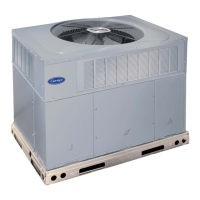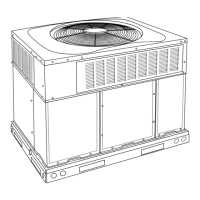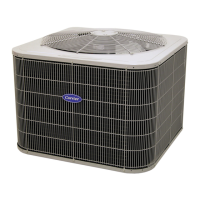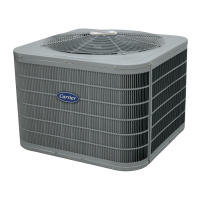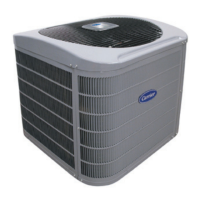48VL-C, 48VL-E: Installation Instructions
Manufacturer reserves the right to change, at any time, specifications and designs without notice and without obligations.
15
• The rated gas inputs shown in Table 6 are for altitudes from sea level
to 2000 ft (610 m) above sea level. These inputs are based on natural
gas with a heating value of 1025 Btu/ft
3
at 0.60 specific gravity, or
propane gas with a heating value of 2500 Btu/ft
3
at 1.5 specific
gravity.
IN THE U.S.A.:
The input rating for altitudes above 2,000 ft (610 m) must be reduced by
4% for each 1,000 ft (305 m) above see level.
For installations below 2,000 ft (610 m), refer to the unit rating plate.
For installations above 2,000 ft (610 m). multiply the input on the rating
plate by the derate multiplier in Table 3 for correct input rate.
IN CANADA:
The input rating for altitudes from 2,000 (610 m) to 4,500 ft (1372 m)
above sea level must be derated 10% by an authorized Gas Conversion
Station or Dealer.
When the gas supply being used has a different heating value or specific
gravity, refer to national and local codes, or contact your distributor to
determine the required orifice size.
Adjust Gas Input
The gas input to the unit is determined by measuring the gas flow at the
meter or by measuring the manifold pressure. Measuring the gas flow at
the meter is recommended for natural gas units. The manifold pressure
must be measured to determine the input of propane gas units.
Measure Gas Flow (Natural Gas Units)
Minor adjustment to the gas flow can be made by changing the manifold
pressure. The manifold pressure must be maintained between 3.2 and 3.8
IN. W.C.
A07751
Fig. 13 – Single-Stage Gas Valve
If larger adjustments are required, change main burner orifices following
the recommendations of national and local codes.
NOTE: All other appliances that use the same meter must be turned off
when gas flow is measured at the meter.
Proceed as follows:
1. Turn off gas supply to unit.
2. Remove pipe plug on manifold (See Fig. 11) and connect
manometer. Turn on gas supply to unit.
3. Record number of seconds for gas meter test dial to make one
revolution.
4. Divide number of seconds in Step 3 into 3600 (number of seconds
in one hr).
5. Multiply result of Step 4 by the number of cubic feet (cu ft) shown
for one revolution of test dial to obtain cubic feet (cu ft) of gas flow
per hour.
6. Multiply result of Step 5 by Btu heating value of gas to obtain total
measured input in Btuh. Compare this value with heating input
shown in Table 6 (Consult the local gas supplier if the heating value
of gas is not known).
EXAMPLE: Assume that the size of test dial is 1 cu ft, one revolution
takes 32 sec, and the heating value of the gas is 1050 Btu/ft
3
. Proceed as
follows:
1. 32 sec. to complete one revolution.
2. 3600 ¸ 32 = 112.5.
3. 112.5 x 1 =112.5 ft3 of gas flow/hr.
4. 112.5 x 1050 = 118,125 Btuh input.
If the desired gas input is 115,000 Btuh, only a minor change in the
manifold pressure is required.
Observe manifold pressure and proceed as follows to adjust gas input:
1. Remove regulator cover screw over plastic adjustment screw on gas
valve (See Fig. 13).
Table 3 – Altitude Derate Multiplier for U.S.A.
*
*. In Canada see Canadian Altitude Adjustment.
Altitude ft (m) Percent of Derate
Derate Multiplier
Factor
†
†. Derate multiplier factors are based on midpoint altitude for altitude range.
0-2000
(0-610)
0
1.00
2001-3000
*
(610-914)
8-12
0.90
3001-4000
(915-1219)
12-16 0.86
4001-5000
(1220-1524)
16-20 0.82
5001-6000
(1524 -1829)
20-24 0.78
6001-7000
(1829-2134)
24-28 0.74
7001-8000
(2134-2438)
28-32
0.70
8001-9000
(2439-2743)
32-36 0.66
9001-10,000
(2744-3048)
36-40 0.62
EXAMPLE:
90,000 Btu/hr Input Furnace Installed at 4300 ft.
Furnace Input Rate at
Sea Level
X
Derate Multiplier
Factor
=
Furnace Input Rate at
Installation Altitude
90,000 X 0.90 = 81,000
CAUTION
!
UNIT DAMAGE HAZARD
Failure to follow this caution may result in reduced unit and/or
component life.
Do Not redrill an orifice. Improper drilling (burrs, out-of-round holes,
etc.) can cause excessive burner noise and misdirection of burner flame.
If orifice hole appears damaged or it is suspected to have been redrilled,
check orifice hole with a numbered drill bit of correct size.
REGULATOR
COVER SCREW
ADJUSTMENT
SCREW
REGULATOR SPRING
(PROPANE - WHITE)
NATURAL - SILVER)
GAS PRESSURE
REGULATOR
ADJUSTMENT
MANIFOLD
PRESSURE TAP
INLET
PRESSURE TAP
ON/OFF SWITCH
PLASTIC
(

